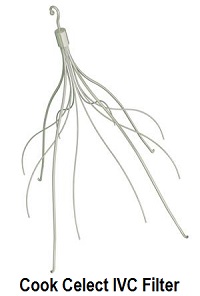 Cook Medical, C.R Bard and other IVC filter makers claim their devices lower rates of venous thromboembolism. But a sharp decline in IVC filter use has failed to affect VTE hospitalization rates.
Cook Medical, C.R Bard and other IVC filter makers claim their devices lower rates of venous thromboembolism. But a sharp decline in IVC filter use has failed to affect VTE hospitalization rates.A letter published in the Journal of the American Medical Association reported in July 2017 that after the FDA issued a safety warning in 2010 about adverse events associated with IVC filters, their use decreased. However, that warning failed to impact VTE hospitalization rates. If the filters were working as advertised, one would have thought that reducing their use would have raised VTE hospitalizations.
Researchers analyzed U.S. rates of IVC filter placement to determine any differences before and after the FDA’s August 2010 advisory. They analyzed VTE hospitalization rates to find whether changes in IVC filter use caused changes in VTE-related hospitalizations.
More than 1 Million Patients Analyzed
Satyajit Reddy, an internal medicine MD at Philadelphia’s Temple University Hospital, and some colleagues analyzed 1,131,274 patients in the National Inpatient Sample database. All had IVC filters placed from 2005 to 2014.
The researchers found IVC filter placement increased 22.2% between 2005 (45.2 per 100,000 U.S. residents) and 2010, the year of the FDA advisory (55.1 per 100,000 U.S. residents).
Placement of the blood-clot filter devices then declined between 2010 and 2014 (39.1 per 100,000 U.S. residents). That is when the statistics became interesting, strongly suggesting that the filters were doing nothing to stop or lower VTE.
Dr. Reddy and his colleagues wrote that the rate of VTE-related hospitalizations did not significantly change between 2010 (211.6 per 100,000 U.S. residents) and 2014 (211.3 per 100,000 U.S. residents).
Research Rebuttals
Although Cardiology Today reported speculation which claimed the decline in IVC filter placements was related to decreased reimbursement due to changes in the bundling of associated Current Procedural Terminology codes that went into effect in 2012, the decline actually began two years earlier, after the FDA advisory, wrote Dr. Reddy and his colleagues.
Dr. Reddy and fellow researchers also speculated that another possible factor was the introduction of nonvitamin K antagonist oral anticoagulants for treatment of VTE, but they also said its impact (if any) on IVC filter placements was not clear.
Decline in IVC filter use fails to affect VTE hospitalization rates
“Given the short- and long-term complications associated with [inferior vena cava filter] placement, the use of these devices should mostly be reserved for patients with an absolute indication like active bleeding,” Dr. Reddy and his colleagues wrote. They also noted that IVC filter placement remains much higher in the U.S. than in Europe, where the rate is less than 3 per 100,000 people.
IVC Filter Lawsuits’
Because IVC filters were never approved by the FDA, and because thousands of people have reported problems with their IVC filters tilting, breaking, and/or migrating, IVC filter lawsuits have been filed across the U.S. Our law firm is handling and filing many of these lawsuits, including several against some of the largest IVC filter makers such as C.R. Bard and Cook Medical. Contact us now for a free legal consultation if you have experienced any problems with an IVC filter.
Related
- IVC Filters not FDA Approved
- IVC Filter Lawsuit | Lawyer
- Bard IVC Filter Lawsuit
- Cook IVC Filter Attorney

by Matthews & Associates




